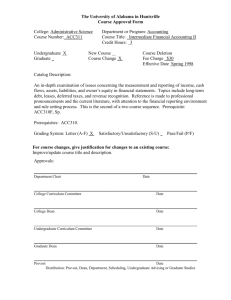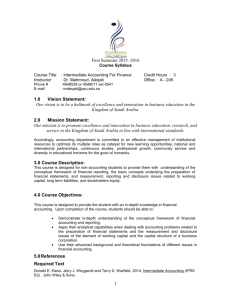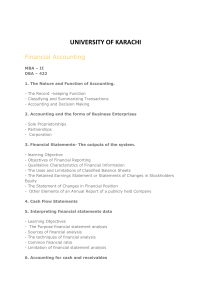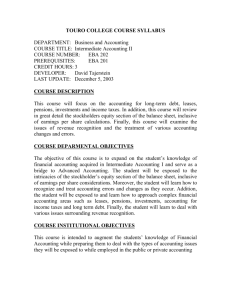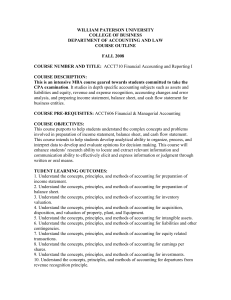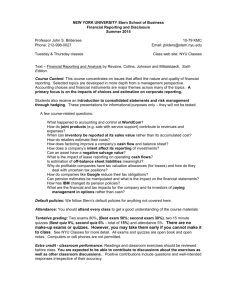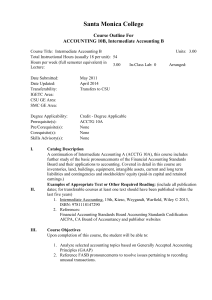COLLEGE OF MICRONESIA
advertisement
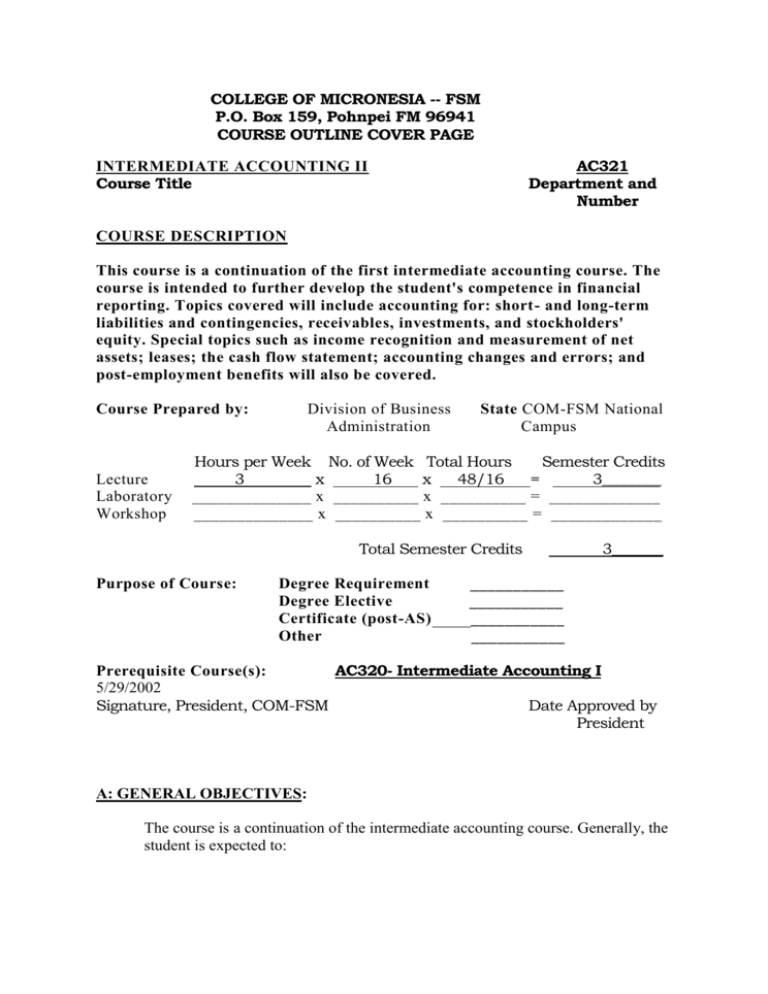
COLLEGE OF MICRONESIA -- FSM P.O. Box 159, Pohnpei FM 96941 COURSE OUTLINE COVER PAGE AC321 Department and Number INTERMEDIATE ACCOUNTING II Course Title COURSE DESCRIPTION This course is a continuation of the first intermediate accounting course. The course is intended to further develop the student's competence in financial reporting. Topics covered will include accounting for: short- and long-term liabilities and contingencies, receivables, investments, and stockholders' equity. Special topics such as income recognition and measurement of net assets; leases; the cash flow statement; accounting changes and errors; and post-employment benefits will also be covered. Course Prepared by: Lecture Laboratory Workshop Division of Business Administration State COM-FSM National Campus Hours per Week No. of Week Total Hours Semester Credits 3 x 16 x 48/16 = 3________ ______________ x __________ x __________ = _____________ ______________ x __________ x __________ = _____________ Total Semester Credits Purpose of Course: Degree Requirement Degree Elective Certificate (post-AS) Other 3_______ ___________ ___________ ___________ ___________ Prerequisite Course(s): AC320- Intermediate Accounting I 5/29/2002 Signature, President, COM-FSM Date Approved by President A: GENERAL OBJECTIVES: The course is a continuation of the intermediate accounting course. Generally, the student is expected to: 1) Further develop and demonstrate competence in financial reporting by preparing, interpreting and analyzing corporate financial statements of intermediate complexity. 2) Demonstrate greater understanding of various disclosure requirements in financial reporting, particularly in regard to liabilities, stockholders’ equity, and other special areas. B: SPECIFIC OBJECTIVES: By the end of the course, the student will be able to: Unit 1: 1. Explain the characteristics of a liability and distinguish between current and long-term liabilities. 2. Account for compensated absences. 3. Calculate and record payroll taxes and deductions. 4. Make reasonable estimations of/record property taxes and warranty obligations. 5. Explain the various contingencies. 6. Differentiate between and report a gain OR loss contingency. 7. Identify, measure, and report current liabilities. Unit 2: 1. 2. 3. 4. 5. 6. 7. 8. Explain the reasons for issuing long-term liabilities. Describe the characteristics of bonds payable. Record the issuance of bonds and amortize bond discounts and premiums. Compute the selling price of bonds. Explain extinguishment of liabilities. Account for bonds with equity characteristics. Account for long-term liabilities and the related disclosure. Account for long-term notes receivable, including impairment of a loan. Unit 3: 1. Explain the classification and valuation of investments and the related disclosures. 2. Account for investments in debt and equity trading securities. 3. Account for investments in available for sale debt and equity securities, 4. Account for investments in held-to-maturity debt security. 5. Account for transfers and impairments. 6. Explain the conceptual issues regarding investments in marketable securities. Unit 4: 1. Describe the corporate form of organization and explain the rights and terms that apply to capital stock. 2. Account for the issuance of capital stock. 3. Differentiate between compensatory and non-compensatory stock option plan 4. Account for a compensatory stock option plan. 5. Describe the characteristics of preferred stock. 6. Explain the components of the Contributed Capital section 7. Account for treasury stock. Unit 5: 1. 2. 3. 4. 5. 6. 7. 8. Compute the weighted average common shares for earnings per share (EPS). Compute basic and diluted EPS and explain their disclosure requirements. Identify the potential common shares included in diluted EPS. Calculate the impact of a convertible security on diluted EPS. Record the declaration and payment of cash dividends. Account for small and large stock dividends and a property dividend. Explain how to report accumulated other comprehensive income. Prepare a statement of changes in stockholders’ equity. Unit 6: 1. Explain revenue recognition alternatives – at time of sale, during production, and at time of cash receipt – and the conceptual issues regarding these alternatives. 2. Account for revenue recognition prior to the period of sale, including the installment and cost recovery methods. 3. Account for revenue recognition after the period of sale, including the installment and cost recovery methods. 4. Account for revenue recognition delayed until a future event occurs. 5. Account for changes in prices. Unit 7: 1. Outline the characteristics of pensions plans. 2. Explain the historical perspective of accounting for pension plans. 3. Explain the accounting principles for defined benefit plans, including computing pension expense and recognizing pension liabilities and assets. 4. Account for pensions and explain the related disclosures. 5. Explain the conceptual issues regarding pensions. Unit 8: 1. 2. 3. 4. 5. 6. Explain the advantages of leasing. Define key terms related to leasing. Explain how to classify leases of personal property. Account for a lessee’s operating and capital leases. Describe disclosures by the lessee and by the lessor. Explain the conceptual issues regarding leases. Unit 9: 1. Classify cash flows as operating, investing, or financing. 2. Identify the categories of inflows and outflows of cash. 3. Compute and report operating cash flows using both direct and indirect method. 4. Prepare a simple statement of cash flows. Unit 10: 1. Identify the types of accounting changes. 2. Explain the methods of disclosing an accounting change. 3. Account for change in accounting principle using the cumulative effect method. 4. Account for a change in accounting principle using a prior period restatement. 5. Account for a change in estimate. 6. Explain the conceptual issues regarding a change in accounting principle and a change in estimate. 7. Identify a change in a reporting entity. 8. Account for a correction of an error. ** The order in which later units (6-10) are covered may be at the instructor’s discretion. C: COURSE CONTENT: Accounting for Current Liabilities Accounting for Contingencies Accounting for Long-term Liabilities Accounting for Receivables Accounting for Investments Accounting for Stockholders’ Equity-Contributed Capital; Retained Earnings; EPS Income Recognition and Net Asset Measurement Accounting for Post Employment Benefits Accounting for Leases The Statement of Cash Flows Accounting Changes and Errors D: TEXTBOOK: Intermediate Accounting, 8th edition, by Nikolai and Bazley. South-Western Publishing: Cincinnati, 2000. Only Chapters 12-17 and 18-22 shall be covered. E: REQUIRED COURSE MATERIALS: Working Papers booklet; Calculator; Pencil F: METHODS OF INSTRUCTION: Lecture, class discussions, projects, quest speakers, and various individual and group assignments. G: EVALUATION: Grades will be assigned based in the following percentage of total points received from projects, quizzes, homework practice sets, and exams. 90-100% = A; 80-89% = B; 70-79% = C; 60-69% = D; 59 and below = F H: CREDIT BY EXAMINATION AVAILABLE FOR THE COURSE: None. I: ATTENDANCE POLICY: The College attendance policy shall be applied.
